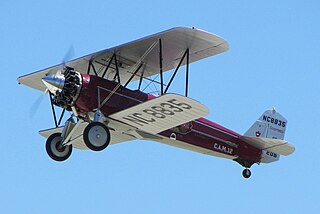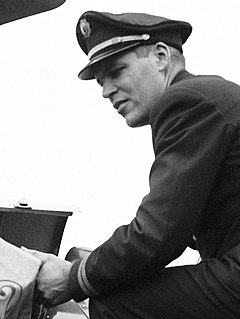
An autogyro, also known as a gyroplane, is a type of rotorcraft that uses an unpowered rotor in free autorotation to develop lift. Forward thrust is provided independently, by an engine-driven propeller. While similar to a helicopter rotor in appearance, the autogyro's rotor must have air flowing across the rotor disc to generate rotation, and the air flows upwards through the rotor disc rather than down.

The Buhl Aircraft Company was a US aircraft manufacturer founded in Detroit in 1925 which remained in operation until 1933. Buhl designed and manufactured the Buhl-Verville CA-3 Airster, the first aircraft to receive a US civil aviation type Certificate in March 1927. Several utility and sport aircraft models were developed from 1925 to 1931, both fixed wings and rotary wing aircraft. Their greatest successes were with the Airsedan and Bull Pup, with approximately 185 aircraft of all types built from 1925 to 1932.

The Pitcairn Mailwing family was a series of American mail carrier and three-seat sport utility biplane aircraft produced from 1927 to 1931.

The Pitcairn OP-1 was the first rotary-wing aircraft to be seriously evaluated by any of the world's major air forces. The machine was not a helicopter, nor an airplane, but an autogyro. Pitcairn's model was never put into production for any military.

The Kayaba Ka-1 and Ka-2 were Japanese autogyros, seeing service during World War II for artillery spotting.

The Cierva C.19 was a 1930s British two-seat autogyro, designed by Spanish engineer Juan de la Cierva. It was built by Avro as the Avro Type 620. It proved to be the most successful and widely produced of the early de la Cierva designs.

The Kellett KD-1 was a 1930s American autogyro built by the Kellett Autogiro Company. It had the distinction of being the first practical rotary-wing aircraft used by the United States Army and inaugurated the first scheduled air-mail service using a rotary-wing aircraft.

The Kellett K-2 was a two-seat autogyro developed in the United States in the early 1930s. Later examples were designated K-3 and K-4 when equipped with more powerful engines. K-3 NC 12691 is seen in the 1934 movie, It Happened One Night.

The Kellett XR-10 was a military transport helicopter developed in the United States in the 1940s that only flew in prototype form. It was designed in response to a USAAF Technical Instruction issued for the development of a helicopter to transport passengers, cargo, or wounded personnel within an enclosed fuselage. Kellett's proposal followed the general layout that the company was developing in the XR-8, with twin intermeshing rotors, and was accepted by the Air Force on 16 October over proposals by Sikorsky, Bell, and Platt-LePage.

The Pitcairn PAA-1 was an autogyro developed in the United States in the early 1930s. Of similar configuration to Pitcairn's earlier machines, the PAA-1 had an airplane-like fuselage with two open cockpits in tandem and a tractor-mounted engine in the nose. It was also equipped with small wings, which carried control surfaces, rather than using the rotor for flight control. It was a smaller and lighter machine than its predecessors and was designed specifically with private pilots in mind.

The Pitcairn PA-18 was an autogyro produced in the United States in the early 1930s.

The Pitcairn PCA-2 was an autogyro developed in the United States in the early 1930s. It was Harold F. Pitcairn's first autogyro design to sell in quantity. It had a conventional design for its day – an airplane-like fuselage with two open cockpits in tandem, and an engine mounted tractor-fashion in the nose. The lift by the four-blade main rotor was augmented by stubby, low-set monoplane wings that also carried the control surfaces. The wingtips featured considerable dihedral that acted as winglets for added stability.

The Stearman C3 was an American-built civil biplane aircraft of the 1920s, designed by Stearman Aircraft of Wichita, Kansas. It was also the first Stearman aircraft to receive a type certificate.

The Stout Skycar was a series of four one-off American light aircraft of the 1930s.

The Swallow Airplane Swallow is an American-built general purpose biplane of the mid- to late 1920s.

The Autogiro Company of America AC-35 was an early attempt to make a roadable aircraft in the United States during the 1930s. Although it was successfully tested, it did not enter production; a 1960s attempt to revive the aircraft in a non-roadable version also failed to achieve success.
The Celier Kiss is a series of Polish autogyros that was designed by Frenchman Raphael Celier and produced by his company, Celier Aviation of Jaktorów-Kolonia, Poland. When it was available the aircraft was supplied as a kit for amateur construction or as a complete ready-to-fly-aircraft.

John MacDonald Miller was a barnstorming pilot, the first person to make a US transcontinental flight in a rotorcraft, the first to land a rotorcraft on the roof of a building, and the first to fly a scheduled US mail rotorcraft service. He was also a test pilot and airline captain. He became the oldest active pilot in the US, making his first flight on his 18th birthday and ending at the age of 101. He died aged 102.

The 1933 experimental Pitcairn PA-22 was one of the first wingless autogyros. It was controlled by movement of the rotor plane rather than the usual control surfaces, though initially the much modified lone example retained rudders as a precaution.


















